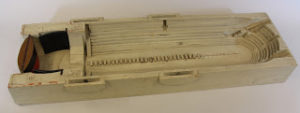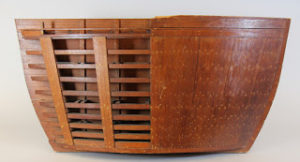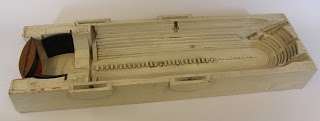We live in an age of engineering marvels. In the last half century, we’ve built bridges that span miles of open sea, tunnels that carry trains deep underground, and buildings that touch the clouds. But for most of us, we barely notice these wonders as we quickly pass by. Lumped under the soporific label “infrastructure,” we lose sight of the ingenuity required to craft these structures.
We weren’t always so jaded by innovation. In the nineteenth century, Americans and foreign visitors alike gaped at the new bridges, aqueducts, and steam engines transforming the nation’s landscape. These projects symbolized the prosperity and forward-thinking nature of the new world, a place where technology and Yankee pluck combined to provide citizens with a happy present and a glorious future.
And yet, even as these works progressed, a candid observer would have found antebellum America a place still rural and underdeveloped, at least by European standards (the measure of all progress for many during the period). A small population and an enormous landmass meant that much of the United States remained forested, and even many of the settled places had a rawness to them.
Of all the national institutions, the United States Navy was perhaps the most ready to innovate and create a lasting foundation for future success. Having proved its capability during the War of 1812, the Navy entered the “Era of Good Feelings” poised to prosper. In 1825 an English tourist wrote, “the navy is the national establishment which the Americans foster with the greatest care, and view with the most affection; and they may well do so, for they have received infinite benefits from its services, and have reason to be proud of the discipline and perfection which their maritime force at present displays.”
Despite the accolades, the Navy had once great Achilles heel: it lacked the facilities to properly service and maintain the fleet. Congress had allowed for the establishment of navy yards up and down the Atlantic and Gulf coasts, but these were more storage facilities than proper dockyards.
Most significant of all was the lack of dry docks. These basins allowed a large vessel to float in on the tide. A gate at the seaward end closed, and as the water was pumped out, the ship settled gently onto blocks and shores. Without a dry dock, careening was the only way to clean or repair a ship’s bottom. This remained a dangerous and time-consuming operation and seemed hardly dignified for a fleet that had taught the British a thing or two at sea (and who, by the way, had built and used dry docks for centuries).
So in 1824 Congress allowed Secretary of the Navy Samuel Southard to study the feasibility of building dry docks at the US Navy’s yards. Southard in turn asked Woburn, Massachusetts-born engineer Loammi Baldwin to perform surveys and prepare reports on the possibilities for dry docks.
Baldwin was a natural choice. Son of Loammi Baldwin, Sr., he’d helped his father with the survey and construction of the Middlesex Canal, an artificial waterway connecting the Merrimac River to Boston Harbor. Loammi Jr. studied law at Harvard, but soon abandoned that profession in favor of mechanics and engineering. During the War of 1812 he supervised the construction of fortifications, and by the 1820s he had many public works projects under his belt.
Baldwin finished his report in 1826 and Southard presented it to Congress in 1827. With money appropriated (the dock would cost as much as two new frigates), he began work on docks at Boston and Norfolk, Virginia. Both were impressive structures, made more so when we remember that the laborers who toiled to excavate a hole 340 feet long and 100 feet wide did so with picks and shovels. The quarrymen and stone masons who dressed the great Quincy granite blocks, “worked with as much neatness and elegance as if the several stones were prepared for the front of a dwelling house,” did it all with hammers and chisels and muscle and sinew. To support the massive weight of the masonry structure, they drove some 4,000 timber pilings into the soft ground below the dock. At the dock’s head rose a three story granite engine house, designed by Alexander Parris, to shelter the “Great Steam Engine for draining the Dock.” Today it houses this museum.




Commodore Hull took the command on deck, assisted by Col. Loammi Baldwin, the chief engineer of this splendid work of art. The vessel was moved into the dock in twenty-five minutes, precisely as a canal boat goes into a lock, and the gates were closed. Rapid salutes were fired from the 74 Columbus, which was housed at the end of the wharf, and also from the Battery… The pumping commenced from the powerful engine of one hundred horse power, used for the purpose, and though but half the pumps were put in motion, a torrent of water was delivered from the drain which entered the river, that would have carried all the Factories in Lowell. It is said that the pumps can deliver 120,000 gallons per minute. The dock may be pumped out in two hours, but the engine was employed from half past 6 until half past 12 before the Dock was dry. The frigate had been shored up, laterally and perpendicularly, as the water fell, and was cradled quietly on blocks placed to receive her keel. Her hull had a venerable appearance, from the moss and bearded grass and muscles with which it was covered. Many of these last were gathered as relics, to be laid up in cabinets. The whole scene was imposing, and was witnessed by several hundreds. The Commodore’s clear voice was repeatedly heard ringing from the quarterdeck of his former glory.
Unlike most of the bridges, monuments, waterworks, and buildings of the early republic, this masterpiece of art and science is still with us. Enlarged in the second part of the nineteenth century and again in the twentieth, the dock evolved to keep pace with the Navy’s ever-changing technology. But through all the alterations, wars, and national emergencies, the Navy was careful to preserve the inscription cut into the hard grey Quincy granite at the dock’s head:
All the classical monuments of history bear the inscriptions of the rulers who ordered them built. In the new United States, the rulers shared the glory with the man from whose mind the structure sprung.
The Author(s)
Matthew Brenckle
Research Historian, USS Constitution Museum
Matthew Brenckle was the Research Historian at the USS Constitution Museum from 2006 to 2016.
